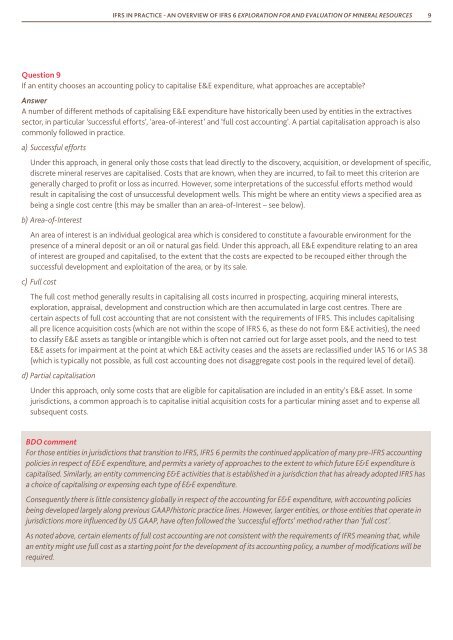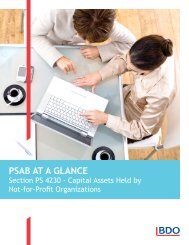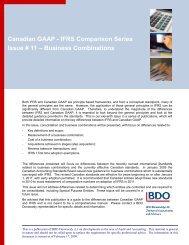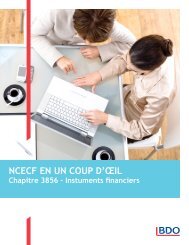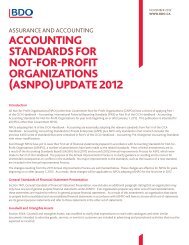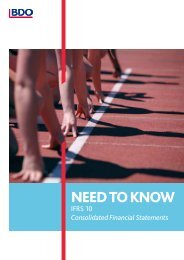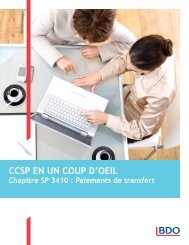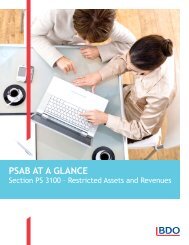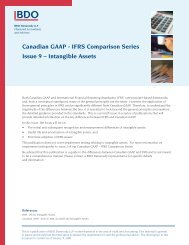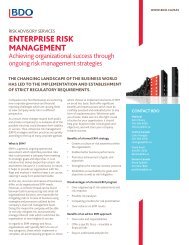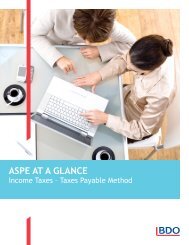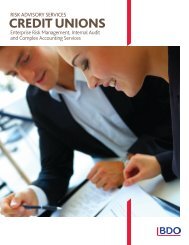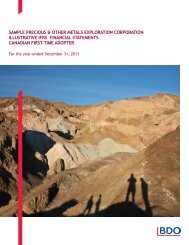IFRS 6 Exploration For and Evaluation of ... - BDO International
IFRS 6 Exploration For and Evaluation of ... - BDO International
IFRS 6 Exploration For and Evaluation of ... - BDO International
- No tags were found...
Create successful ePaper yourself
Turn your PDF publications into a flip-book with our unique Google optimized e-Paper software.
<strong>IFRS</strong> IN PRACTICE - AN OVERVIEW OF <strong>IFRS</strong> 6 EXPLORATION FOR AND EVALUATION OF MINERAL RESOURCES9Question 9If an entity chooses an accounting policy to capitalise E&E expenditure, what approaches are acceptable?AnswerA number <strong>of</strong> different methods <strong>of</strong> capitalising E&E expenditure have historically been used by entities in the extractivessector, in particular ‘successful efforts’, ‘area-<strong>of</strong>-interest’ <strong>and</strong> ‘full cost accounting’. A partial capitalisation approach is alsocommonly followed in practice.a) Successful effortsUnder this approach, in general only those costs that lead directly to the discovery, acquisition, or development <strong>of</strong> specific,discrete mineral reserves are capitalised. Costs that are known, when they are incurred, to fail to meet this criterion aregenerally charged to pr<strong>of</strong>it or loss as incurred. However, some interpretations <strong>of</strong> the successful efforts method wouldresult in capitalising the cost <strong>of</strong> unsuccessful development wells. This might be where an entity views a specified area asbeing a single cost centre (this may be smaller than an area-<strong>of</strong>-Interest – see below).b) Area-<strong>of</strong>-InterestAn area <strong>of</strong> interest is an individual geological area which is considered to constitute a favourable environment for thepresence <strong>of</strong> a mineral deposit or an oil or natural gas field. Under this approach, all E&E expenditure relating to an area<strong>of</strong> interest are grouped <strong>and</strong> capitalised, to the extent that the costs are expected to be recouped either through thesuccessful development <strong>and</strong> exploitation <strong>of</strong> the area, or by its sale.c) Full costThe full cost method generally results in capitalising all costs incurred in prospecting, acquiring mineral interests,exploration, appraisal, development <strong>and</strong> construction which are then accumulated in large cost centres. There arecertain aspects <strong>of</strong> full cost accounting that are not consistent with the requirements <strong>of</strong> <strong>IFRS</strong>. This includes capitalisingall pre licence acquisition costs (which are not within the scope <strong>of</strong> <strong>IFRS</strong> 6, as these do not form E&E activities), the needto classify E&E assets as tangible or intangible which is <strong>of</strong>ten not carried out for large asset pools, <strong>and</strong> the need to testE&E assets for impairment at the point at which E&E activity ceases <strong>and</strong> the assets are reclassified under IAS 16 or IAS 38(which is typically not possible, as full cost accounting does not disaggregate cost pools in the required level <strong>of</strong> detail).d) Partial capitalisationUnder this approach, only some costs that are eligible for capitalisation are included in an entity’s E&E asset. In somejurisdictions, a common approach is to capitalise initial acquisition costs for a particular mining asset <strong>and</strong> to expense allsubsequent costs.<strong>BDO</strong> comment<strong>For</strong> those entities in jurisdictions that transition to <strong>IFRS</strong>, <strong>IFRS</strong> 6 permits the continued application <strong>of</strong> many pre-<strong>IFRS</strong> accountingpolicies in respect <strong>of</strong> E&E expenditure, <strong>and</strong> permits a variety <strong>of</strong> approaches to the extent to which future E&E expenditure iscapitalised. Similarly, an entity commencing E&E activities that is established in a jurisdiction that has already adopted <strong>IFRS</strong> hasa choice <strong>of</strong> capitalising or expensing each type <strong>of</strong> E&E expenditure.Consequently there is little consistency globally in respect <strong>of</strong> the accounting for E&E expenditure, with accounting policiesbeing developed largely along previous GAAP/historic practice lines. However, larger entities, or those entities that operate injurisdictions more influenced by US GAAP, have <strong>of</strong>ten followed the ‘successful efforts’ method rather than ‘full cost’.As noted above, certain elements <strong>of</strong> full cost accounting are not consistent with the requirements <strong>of</strong> <strong>IFRS</strong> meaning that, whilean entity might use full cost as a starting point for the development <strong>of</strong> its accounting policy, a number <strong>of</strong> modifications will berequired.


